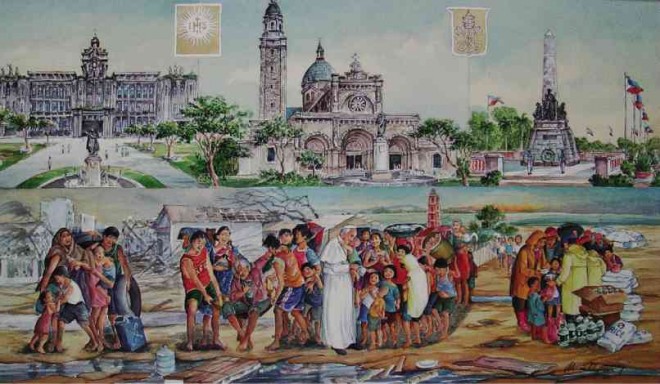Self-taught artist Alvaro Jimenez, 67, did not set out to be different. But he has evolved into a league of his own.
Jimenez paints on banana stalks that he dries and treats with silica gel. On these organic canvases emerge his frequent images of a mother and child, dressed in “baro’t saya,” often rendered to evoke a peaceful or playful mood.
He is also master of the rare art form “letras y figuras” (letters and figures) that another artist, Jose Honorato Lozano, pioneered in the country in mid-19th century.
The auction house, Christie’s, described Lozano as a “practitioner of the unusual art form known as letras y figuras in which a patron’s name is composed by elaborate arrangements of figures (“tipos del pais”) surrounded by vignettes of scenes in Manila.”
Christie’s has custody of the Jean Flebus Manila Album, a collection of 25 watercolors by Lozano bought by Flebus’ great-great grandfather, Belgian trader Emile Nyssens.
Lozano’s legacy
By chance, Jimenez said, he found himself continuing the legacy of Lozano.
In his start-up year in 1976—when teaching at the then Don Honorio Ventura College of Arts and Trade was his bread and butter—Jimenez painted on Bauhinia leaves that were shaped like an apple and bigger than a saucer.
When these pieces became popular, he broke out from the fad and experimented on corn leaves and banana stalks.
“It is easier to paint on stalks because [acrylic] paint and stalks help each other out. And stalks have long life,” Jimenez said at the opening of an exhibit of his selected works.
The city government of San Fernando mounted the exhibit at the SM City San Fernando here on Friday for the 117th anniversary of the declaration of Philippine Independence.
As for letras y figuras, Lozano credits Sonia Ner, former director of Ayala Museum, for introducing him to this art form in 1988. Ner, he recalled, asked him to make a letras y figuras of the word “Pasko” (Christmas) for the museum shop.
She printed Jimenez’s rendition on Christmas cards that enjoyed brisk sale.
Since then, Jimenez has accepted commissioned works for, among others, Queen Sofia of Spain and the late President Corazon Aquino.
One of his latest commissioned works was from Pampanga Auxiliary Bishop Pablo Virgilio David as a gift to Pope Francis in January.
‘Ad majorem dei gloriam’
Inside the letters AMDG (the Jesuit motto “ad majorem dei gloriam” or “to the glory of God”) are images of people expressing their Catholic faith in various acts.
The letters were set against a backdrop of the University of Sto. Tomas, the Manila Cathedral and the Rizal Park.
One of the biggest works Jimenez has produced is a 1.2 x 3.04 meter (4 x 10 feet) piece commissioned by the city government which features elements depicting industrious folk.
In “Mabuhay,” he presents several festivals in the country such as the Panagbenga Flower Festival of Baguio City, the Sinulog of Cebu City, the Masskara of Bacolod City and the Ati-Atihan of Kalibo, Aklan.
Jimenez said sustaining letras y figuras requires a lot of patience because of the time needed to compose a piece of work. He said his hometown Bacolor, in its pre-Pinatubo glory, has enriched his visual acuity for rural and antique landscapes.
